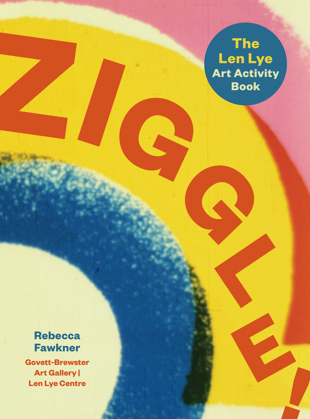Q1: You teach school children in an amazing place — the Len Lye Centre in New Plymouth. What five adjectives would you use to describe the emotional effect on children when they see one of his kinetic works in action?
Enraptured, alarmed, intrigued, immersed, tickled.
Q2: Why do you think they engage so deeply with his work?
In a sense, children are Len’s perfect audience as they are naturally ‘body people’ just as he was. They are not too self-conscious about responding to the sculpture’s performance with their whole bodies.
Q3: Translating some of that into the pages of a book so they can take that Len Lye magic home must have been a challenge. Is that where the book’s structure came in?
When kids come face to face with Len’s art it does a lot of the talking itself and kids tend to pick up Len’s ideas naturally. As gallery educators, when we help a class interpret the art we tend to throw our whole selves into it and encourage tamariki to do the same as there are so many ways to communicate other than just with words. Finding ways to activate that Len Lye magic in a book was an intriguing task and the structure was planned to help build up kids’ confidence as they go. It’s also where the importance of great graphic design comes in.
Q4: Had you tried out quite a few of the activities with your classes so you knew which activities were tried-and-true and would work?
Yes, many of them are our ‘top hits’ but of course the way kids respond at home to a book will be different to how they respond in the art studio after meeting Len’s art in person. If a reader takes an activity off in their own direction that’s brilliant and what it’s all about.
Q5: This book has strong aspirations to help children see themselves as artists. Why is that important?
To Len Lye, to be an artist was to have curiosity, a quality that children are naturally full of, so to be a child is to be an artist. Making art Len Lye-style means a journey of discovery so the idea is to get comfortable taking creative risks and to resist shutting down when you have a flop. Children learn so many transferable skills from making art. We host a lot of families in the gallery art studio, and family conversations around the art table confirm that many grown-ups who claim not to be artistic find once they get into it how enjoyable and satisfying art making can be.
Q6: Len Lye’s childhood was remarkable. How do you think children will relate to that?
Living at a lighthouse and free-roaming on the rocks and beaches sounds like a magical story that most of us can only admire. When children hear about young Len’s discovery of those easily ignored details of the world around him and his passion to get into art and drawing, they get it.
Q7: Which activity would you yourself most enjoy doing and why?
I didn’t meet Len’s art until I was a grown-up, but it was love at first sight. I was inspired to really pay attention to things I hadn’t taken time to focus on before, like the particular way the waves roll over or the pattern the twinkles of the sun make on the sea. I also loved his idea of ‘empathy’ or ‘Body English’ as he calls it. It hadn’t occurred to me that the sensation of feeling movement made by another in one’s own body could be an inspiration for art. I think any of those noticing and sensing activities are my favourites. Oh, and the shadow puppet play — always so much fun.
Q8: At the back of the book, you urge its young users to not throw the book away when they’ve done all the activities but to keep it and look back on it. Why?
Len Lye was quite a philosopher and he was also a teacher. He made many audio tapes and lectures in which he explained his ideas. Collecting and valuing your own artistic output for future inspiration is one of them. He collected his early doodles and revisited some of them many times. He saw this as part of his ‘Old Brain’ philosophy. He also loved children’s drawings and kept his own collection. He
had strong ideas about its Old Brain value as well. This book attempts to live out those theories.
Q9: What do you hope young readers, their families and caregivers will take away from both reading and using this book?
Len Lye approached life and art in a very enthusiastic way, I hope that his energy comes through in this book and is catchy. Once he got a good idea he’d keep at it and try it out using different media or art forms. If it didn’t work he scribbled NG (no good) on it and carried on with something different. That’s a great attitude.
Q10: What do you hope Len would say if he were alive for you to give him a copy?
I hope he would invent a new word to describe it! Maybe ZIGGLETASTIC?!


